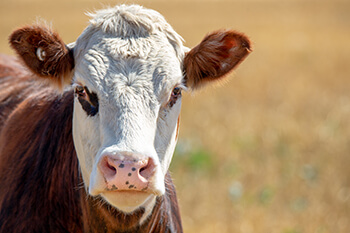Beef Cattle Deworming Strategies
Aug 20, 2019

Beef cattle deworming is very important to reduce internal parasites. Cattle are not only threatened by outside pests like face flies and horn flies, but also internal parasites like lungworms and gastrointestinal roundworms. Anthelmintics or dewormers are used to control these internal parasites. Some anthelmintics are also effective against external parasites.
Parasites can lead to reduced performance in cattle. Losses can result from depressed feed intake and conversion, lower average daily gain or milk production and lower reproductive performance. Parasites are also very dangerous for the health of the animal. They can lead to reduced immunity, reduced weight and the appearance of diseases like anemia. It is very important to detect the signs of infection by these parasites to prevent any major losses to the herd. One effective tool for monitoring parasite loads in cattle is to conduct routine fecal analysis. This allows for more efficient and timely implementation of deworming programs.
To better justify the costs of beef cattle deworming and handling, it is important to understand when deworming is most effective. Cattle usually get infected with parasites from the pastures they graze. Larvae from worms live and thrive in the pastures and infect cattle when they ingest this grass. The grass has to be wet from either rain or dew, and the soil temperature has to be above 55 degrees for the larvae to reach the grass blades. Larvae cannot swim to the grass blades when grasses are dry. Larvae numbers decline significantly when the sun dries the pastures for several weeks, so there is reduced danger of worm infestation at this time and consequently reduced benefit from deworming. Timing is critical for strategic dewoming programs. If you effectively deworm cattle in the fall coming off pasture, they should remain clean all winter. At spring pasture turnout, the risk for parasite infection increases.
Age of the animal may impact parasite loads. Older cows are not as susceptible to worm infections as they gradually develop immunity. Nursing calves on the other hand are at high risk of internal worms and it is vital to deworm them at the appropriate time. Deworming at earlier stages of infection can result in improved weaning weights. It is best to deworm nursing calves at three months of age or late June for spring calving herds or calves six to eight weeks after turnout onto pasture. Reducing the calf parasite load should increase subsequent weaning weights by 10 to 20 pounds per calf. Mid-summer processing also provides the opportunity for additional management like implanting, tagging, vaccinating or sorting.
Many effective products are available including pour-on, feed through and injectables. Consult with your veterinarian to set-up a deworming program that fits your production and management goals. Cattle prices today allow additional management like deworming to pay significant dividends.
Don’t miss your opportunity this spring to cash larger cattle checks come fall!
Parasites can lead to reduced performance in cattle. Losses can result from depressed feed intake and conversion, lower average daily gain or milk production and lower reproductive performance. Parasites are also very dangerous for the health of the animal. They can lead to reduced immunity, reduced weight and the appearance of diseases like anemia. It is very important to detect the signs of infection by these parasites to prevent any major losses to the herd. One effective tool for monitoring parasite loads in cattle is to conduct routine fecal analysis. This allows for more efficient and timely implementation of deworming programs.
To better justify the costs of beef cattle deworming and handling, it is important to understand when deworming is most effective. Cattle usually get infected with parasites from the pastures they graze. Larvae from worms live and thrive in the pastures and infect cattle when they ingest this grass. The grass has to be wet from either rain or dew, and the soil temperature has to be above 55 degrees for the larvae to reach the grass blades. Larvae cannot swim to the grass blades when grasses are dry. Larvae numbers decline significantly when the sun dries the pastures for several weeks, so there is reduced danger of worm infestation at this time and consequently reduced benefit from deworming. Timing is critical for strategic dewoming programs. If you effectively deworm cattle in the fall coming off pasture, they should remain clean all winter. At spring pasture turnout, the risk for parasite infection increases.
Age of the animal may impact parasite loads. Older cows are not as susceptible to worm infections as they gradually develop immunity. Nursing calves on the other hand are at high risk of internal worms and it is vital to deworm them at the appropriate time. Deworming at earlier stages of infection can result in improved weaning weights. It is best to deworm nursing calves at three months of age or late June for spring calving herds or calves six to eight weeks after turnout onto pasture. Reducing the calf parasite load should increase subsequent weaning weights by 10 to 20 pounds per calf. Mid-summer processing also provides the opportunity for additional management like implanting, tagging, vaccinating or sorting.
Many effective products are available including pour-on, feed through and injectables. Consult with your veterinarian to set-up a deworming program that fits your production and management goals. Cattle prices today allow additional management like deworming to pay significant dividends.
Don’t miss your opportunity this spring to cash larger cattle checks come fall!